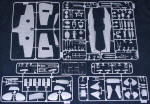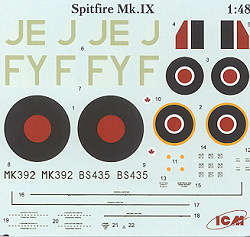
| KIT: | ICM 1/48 Spitfire IX |
| KIT #: | 48061 |
| PRICE: | $23.00 MSRP |
| DECALS: | Two options |
| REVIEWER: | Scott Van Aken |
| NOTES: |

| HISTORY |
The Spitfire Mk. IX is what should be called a stopgap fighter. That means that they took an existing airframe and stuck a new engine into it. In this case, the new two stage Merlin was placed into a Mk.V airframe. This was done because it was a quick and easy thing to do. The engine was really designed for the Mk.VIII, whose airframe incorporated a number of improvements such as a retractable tail wheel, but since the engine bolted right up to the earlier airframe, it was felt, why not?
The result was a world class interceptor that was able to match the new Focke-Wulf 190A that had appeared over the skies of Northern Europe. Had it not been for the 190, the Spit IX would probably not been produced. The IX kept all of the features of the earlier Mk.V, including its superb handling and short range. There was an underfuselage tank developed, but it was bulky and leached away any performance increase the new engine provided. Why the Spit was not supplied with a teardrop shaped drop tank to extend its range is beyond me. Perhaps they felt that the US would provide all the long range fighters needed so no real effort was put into it. Anyway, the Mk.IX eventually took on all of the traits of the Mk.VIII except the lengthened ailerons, so late IXs are nearly indistinguishable from the Mk. VIII.
| THE KIT |
 When
the previous incarnation of ICM originally released this kit, it was a real
mixed bag. First of all ICM made a highly detailed kit of what has to be one of
the most popular versions. The kit includes a full engine with mounts and very
nicely done detailing. The interior is also quite well done with well-formed
detail on the sidewalls of the cockpit. It was designed with multiple options to
do several of the Spit IX family. However, the quality control was horrible and
all of the initial production kits were marred by massive sink areas on the
fuselage, wings, landing gear, prop blades, and really just about every other
thick part. Nothing that couldn't be fixed (except perhaps for the landing gear
and wheels) but it really ruined the old ICM's reputation and I fear that it had
much to do with its eventual failure, despite improvements in production control
to eliminate the greatest of the problems.
When
the previous incarnation of ICM originally released this kit, it was a real
mixed bag. First of all ICM made a highly detailed kit of what has to be one of
the most popular versions. The kit includes a full engine with mounts and very
nicely done detailing. The interior is also quite well done with well-formed
detail on the sidewalls of the cockpit. It was designed with multiple options to
do several of the Spit IX family. However, the quality control was horrible and
all of the initial production kits were marred by massive sink areas on the
fuselage, wings, landing gear, prop blades, and really just about every other
thick part. Nothing that couldn't be fixed (except perhaps for the landing gear
and wheels) but it really ruined the old ICM's reputation and I fear that it had
much to do with its eventual failure, despite improvements in production control
to eliminate the greatest of the problems.
Well, ICM had too many good things going for it to die, so the company was purchased and production reinstated a year or so back. Thankfully, they decided to continue with the Spitfires. So, what is different about this one compared to the one of years gone by? Well, the biggest one I see is that the vast majority of the production problems are gone. I have looked at several of these kits and while all of them show some sink marks on the wing parts and prop blades, gone are the really horrid ones on the fuselage and the landing gear and just about everywhere else. Those still on the wings are concentrated at the aileron hinge line for the top and on the underside opposite some thick reinforcements near the radiator. The elevators also have some sink on the thickest parts as do the prop blades, but they are nowhere near as deep as before and are easily taken care of.
The other big difference is that the sprues for all of the non-bubble canopy kits are identical. You get the different rudders, elevators, wing tips, gun barrels, bombs, cannon fairings and such. This means that if you buy as Spit IX, you can do a VIII or VIII from the kit, though the instructions only show the Mk. IX assembly and parts. The kit includes, as mentioned earlier, a complete engine, though if you show the engine, you won't be able to attach all the cowling panels as they just won't fit well. You can also show the gun bays open as guns are provided. A separate canopy allows the interior to be shown or you can use the one piece option. For ordnance, you can attach either rocket rails or bomb racks to the outer wings. For the centerline there is a ferry tank or a larger bomb rack. Four spoke wheels are provided, though I should point out that some late war Spits used three spoke versions. A lower cowling with the larger filtered intake is also an option.
As you can see, lots of different ways to do this one as the Spit IX was very much a work in progress when it was originally developed using old Spit V/Spit I or II fuselages with the newer Merlin engine.
 Instructions
seem very much to be like what was originally produced as the sprue images show
large gaps in the sprues that are not currently there. Markings are for two
aircraft, both in the Dark Green/Ocean Grey over Medium Sea Grey with yellow
wing leading edge ID bands and Sky fuselage band and spinner. The box art plane
is Johnny Johnson's aircraft when he was wing leader of 144 Wing during D-day,
thus you'll have to paint on some invasion stripes. You could also be lazy and
paint things as it was a couple of days before the markings were added! The
other option is for a 611 Sq aircraft from 1942. As you can see, you have both
ends of the Mk IX spectrum provided. The previous boxing provided marks for four
aircraft, so some things have changed in this regard as well. Markings are
fairly well printed, though my example had most of the bits in black ink
smeared. They are quite matte.
Instructions
seem very much to be like what was originally produced as the sprue images show
large gaps in the sprues that are not currently there. Markings are for two
aircraft, both in the Dark Green/Ocean Grey over Medium Sea Grey with yellow
wing leading edge ID bands and Sky fuselage band and spinner. The box art plane
is Johnny Johnson's aircraft when he was wing leader of 144 Wing during D-day,
thus you'll have to paint on some invasion stripes. You could also be lazy and
paint things as it was a couple of days before the markings were added! The
other option is for a 611 Sq aircraft from 1942. As you can see, you have both
ends of the Mk IX spectrum provided. The previous boxing provided marks for four
aircraft, so some things have changed in this regard as well. Markings are
fairly well printed, though my example had most of the bits in black ink
smeared. They are quite matte.
There are a plethora of aftermarket decals and some excellent resin parts from Ultracast for this kit.
| CONCLUSIONS |
Despite more recent or equivalent aged kits from Hasegawa and Airfix in the recent years, this is still the most accurate Spitfire IX kit on the market in this scale. It is great that it will be more easily obtained in the US and I can tell you from building these kits that they have a lot to offer.
May 2006
If you would like your product reviewed fairly and quickly by a site that has over 300,000 visitors a month, please contact me or see other details in the Note to Contributors.